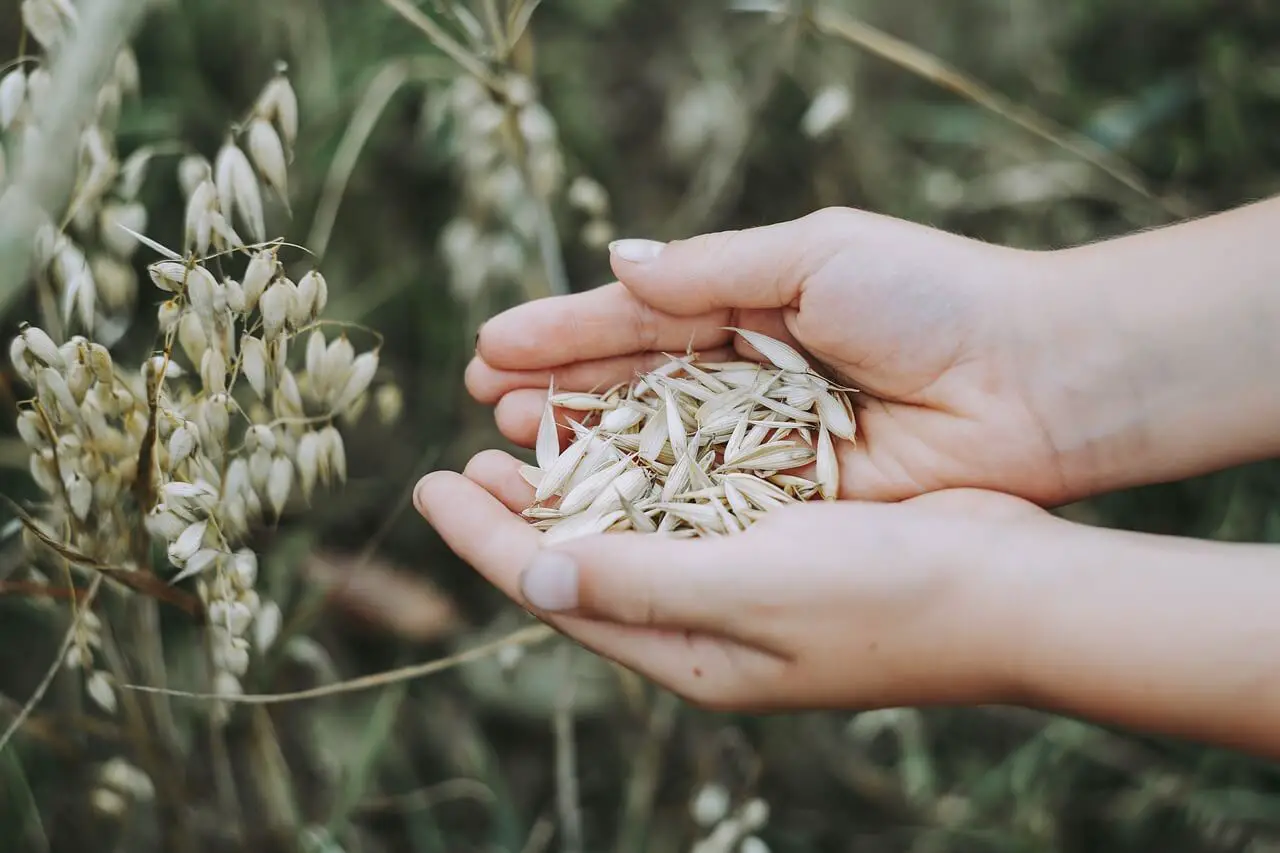8 Grains You Can Grow in a Small Garden
November, 2022 |Growing our own fruits and vegetables is a great way to add a mix of varied nutrition into our diet, but our usual garden veg doesn’t always provide the full range of nutrition that our bodies need. Growing grains is a way to supplement our diets with additional protein, fiber, and valuable micronutrients.
Grains are thought to be the first plants ever domesticated by humans, which means we have an incredible amount of history and knowledge about them! And it shows how deeply valued they were as a source of energy and nutrition.
Grains you can grow in a small garden
Even in a small garden, you can still supplement meals with a little homegrown grain. And while you’re not likely to produce enough to sustain you throughout the year there are other benefits to growing your own grain…
- you can create meals that are truly ‘homegrown’ like a homemade quinoa salad with parsley, cucumber, onion, and pepper.
- Homegrown grains with minimal processing are highly nutritional and can supplement your diet.
- Knowing how to grow these grains is an incredibly rewarding experience that can make us appreciate our connection to food.
- Grain plants can have beautiful flowers or an ornamental shape that looks great in a garden — making harvesting the grains an added bonus!
The following 8 grains are some of the most common and easiest to grow. They’re a mix of heights, but all are suitable for growing in a small garden space.
1. Amaranth
An amazing ancient grain to grow in a small garden, amaranth was once known as ‘the food of the gods’ in Aztec civilizations. Both chia and amaranth were two of the most important crops grown in South America for their nutrition.
Amaranth is a brilliant high-energy and gluten-free grain to grow in a small garden. It’s also a pseudocereal, which means it’s not a member of the grass family, unlike most cereals (wheat, barley etc).
It’s generally considered an invasive plant, so growing them in a raised bed or containers is a great way to control the spread of its seeds. They can become pretty tall (over 6ft) so they made need staking to support the heavy flower stems.
The seeds are very small and are easy to remove from the husk, so handle the dried flower heads with care otherwise you could lose a lot of your harvest.
What to do with homegrown amaranth:
You could mix a handful of seeds in with other grains to make flour for bread. Or simply use the cooked grains in a salad or as a side dish to replace rice.
2. Buckwheat
Another gluten-free super grain, buckwheat is one of the smallest grain plants to grow on this list. At roughly 2ft tall, it’s definitely easier to manage and care for — especially in a small garden.
It grows quickly too, reaching maturity in around 3 months, so you could grow buckwheat in late summer after harvesting other vegetables. It’s a pollinator-friendly plant too as it attracts lots of bees!
What to do with homegrown buckwheat:
Buckwheat makes an excellent flour that you can use to make gluten-free pancakes. The grains also work really well in warm salads, stews, and as an alternative to rice and couscous. You could even blend them and add them to a homemade veggie burger recipe to add protein and help to bind the mixture.

3. Rye
Like buckwheat, rye is not quite as tall as some of the other grain plants on this list (5ft), making it a bit more manageable in a small garden space.
It’s a small grain that’s easy to grow, but one issue to look out for is the ergot fungus. This fungi can infect rye grains and can make you really ill if you eat them.
Typically you could expect to produce up to 1.5kg of rye seeds per 10ft by 2ft space. It’s enough to make a few small loaves of sourdough bread.
What to do with homegrown rye:
Use it to make your own flour! You can buy mini mills to process your own grain. Samap is a French company that produces mini kitchen mills. You can make your own special, homemade rye bread, or use rye flour to supplement other bread recipes.

4. Oats
Oat plants are easy to grow, but it can be labor-intensive to remove the oats themselves. To combat this you can find hulls or ‘naked’ oat varieties to make winnowing easier.
Another issue to be aware of is that oats can also be susceptible to ergot fungi, but not as much as rye.
The seed heads alone look really ornamental and can be a nice addition to a small garden.
What to do with homegrown oats:
After separating out the seeds or ‘oat groats’, you create your own rolled oats! Soak the oats for 8 hours, then strain, and roll them through a pasta rolling machine. Use them in endless baked recipes or simply enjoy your own homegrown porridge.

5. Barley
Another small grain plant, barley is a grass species that produces flower spikes filled with seeds. Barley plants grow quickly, usually maturing in 60-70 days.
It’s a great grain to grow in cooler climates, and you can even get winter barley varieties that you can plant in October for a spring harvest. This is a great way to maximize the growing space in a small garden!
Like oats, barley can also be susceptible to ergot fungi, so double-check for any small black growths.
What to do with homegrown barley:
Add barley to soups and stews where it can be cooked through well to reduce its chewiness. You can also turn barley seeds into barley flour to create bread, pancakes, and other baked goods.

6. Millet
Like barley, millet also grows quickly, usually maturing in 60+ days. Millet plants produce tall spires of white flower clusters, which will soon ripen into swollen seeds.
Some of the most popular varieties include proso millet (Panicum miliaceum) and pearl millet (Pennisetum glaucum). Millet is a re-emerging ancient grain that is becoming a popular and nutritious ingredient!
What to do with homegrown millet:
Add the grains into granola or cook them up to create a breakfast porridge. They are also used as an ingredient in stews and soups, and also as a stuffing for peppers and other vegetables when mixed with herbs and spices.

7. Sorghum
Another millet grass species, but one that is usually categorized as a different cereal. It’s often mistaken for corn, as sorghum can become a very tall plant (8ft). Make sure you’ve got some stakes ready to support them!
To check if the seeds are ready, make sure the flowers are dark red, then press a seed with your fingernail. If you can’t dent the seed, they’re ripe enough and ready for harvest!
What to do with homegrown sorghum:
The stalks of some varieties are used to create sorghum syrup, but the grains can be used much like amaranth and buckwheat. Add the cooked grains to a warm salad or eat them as a breakfast porridge. Or simply enjoy them as a cooked side dish with meals.

8. Quinoa
Quinoa plants are really easy to grow and as a bonus, they produce beautiful and super-dense flower clusters in shades of pink and orange. They usually grow pretty tall, so you might need to add some bamboo or plant supports as they mature.
Quinoa is a cool season crop, so will do well in USDA zones 5-10.
To separate the seeds, wait until the flowers have dried and turned brown/orange then collect the flowers. You’ll then need to follow a process of winnowing, to separate the chaff from the seed. Before eating, make sure you soak and rinse the seeds a few times to leach away the bitter seed coating.
What to do with homegrown quinoa:
Add the grains to salads. They’re high in fiber and protein which makes quinoa a great ingredient for vegans and vegetarians.
Where to find grain seeds to grow
As grains are less common to grow in gardens compared to vegetables or fruits, the seeds are a little harder to find.
Look for them in specialist online shops and even marketplaces like Etsy or eBay where people may practice seed saving.
Tips for growing grains in a small garden
These grains are easy to grow, but to get them off to the best start, and to improve your harvest, check out our tips below…
- Plant them in the sunniest spot in your garden
- Some of these plants can reach heights of 8ft, so make sure you have small tall stakes or bamboo canes to support them.
- Double-check the exact growing conditions needed for each grain. In a small garden space, this will help to really maximize your grain crop yield! Some thrive in poor soil (buckwheat) others need more nutrition.
For more tips, check out our guide to growing grains in a small garden, like a balcony or small apartment patio.

It’s really important to be aware of the small yield. If you have a really small balcony, it might be better to dedicate the space to vertically growing crops, like mini pumpkin varieties or columnar apple trees. But if you love the idea of trying it out, you’ll definitely get a lot of enjoyment in connecting to the old tradition of growing grains.
Grain growers with tractors and specialist harvesting equipment will get way more lbs of grain compared to the work they put in. So growing grains in a small garden is definitely a labor of love. In a small garden, you’re unlikely to get a harvest that you can store and dip into all year.
But it’s still an amazing way to add another homegrown, protein and fiber-rich ingredient into your meals. Plus knowing how to grow your own grain is really satisfying!
Featured Image: Image by Markus Spiske from Pixabay







